Huawei Sun
4D mmWave Radar in Adverse Environments for Autonomous Driving: A Survey
Mar 31, 2025Abstract:Autonomous driving systems require accurate and reliable perception. However, adverse environments, such as rain, snow, and fog, can significantly degrade the performance of LiDAR and cameras. In contrast, 4D millimeter-wave (mmWave) radar not only provides 3D sensing and additional velocity measurements but also maintains robustness in challenging conditions, making it increasingly valuable for autonomous driving. Recently, research on 4D mmWave radar under adverse environments has been growing, but a comprehensive survey is still lacking. To bridge this gap, this survey comprehensively reviews the current research on 4D mmWave radar under adverse environments. First, we present an overview of existing 4D mmWave radar datasets encompassing diverse weather and lighting scenarios. Next, we analyze methods and models according to different adverse conditions. Finally, the challenges faced in current studies and potential future directions are discussed for advancing 4D mmWave radar applications in harsh environments. To the best of our knowledge, this is the first survey specifically focusing on 4D mmWave radar in adverse environments for autonomous driving.
MutualForce: Mutual-Aware Enhancement for 4D Radar-LiDAR 3D Object Detection
Jan 17, 2025Abstract:Radar and LiDAR have been widely used in autonomous driving as LiDAR provides rich structure information, and radar demonstrates high robustness under adverse weather. Recent studies highlight the effectiveness of fusing radar and LiDAR point clouds. However, challenges remain due to the modality misalignment and information loss during feature extractions. To address these issues, we propose a 4D radar-LiDAR framework to mutually enhance their representations. Initially, the indicative features from radar are utilized to guide both radar and LiDAR geometric feature learning. Subsequently, to mitigate their sparsity gap, the shape information from LiDAR is used to enrich radar BEV features. Extensive experiments on the View-of-Delft (VoD) dataset demonstrate our approach's superiority over existing methods, achieving the highest mAP of 71.76% across the entire area and 86.36\% within the driving corridor. Especially for cars, we improve the AP by 4.17% and 4.20% due to the strong indicative features and symmetric shapes.
LiRCDepth: Lightweight Radar-Camera Depth Estimation via Knowledge Distillation and Uncertainty Guidance
Dec 20, 2024Abstract:Recently, radar-camera fusion algorithms have gained significant attention as radar sensors provide geometric information that complements the limitations of cameras. However, most existing radar-camera depth estimation algorithms focus solely on improving performance, often neglecting computational efficiency. To address this gap, we propose LiRCDepth, a lightweight radar-camera depth estimation model. We incorporate knowledge distillation to enhance the training process, transferring critical information from a complex teacher model to our lightweight student model in three key domains. Firstly, low-level and high-level features are transferred by incorporating pixel-wise and pair-wise distillation. Additionally, we introduce an uncertainty-aware inter-depth distillation loss to refine intermediate depth maps during decoding. Leveraging our proposed knowledge distillation scheme, the lightweight model achieves a 6.6% improvement in MAE on the nuScenes dataset compared to the model trained without distillation.
GET-UP: GEomeTric-aware Depth Estimation with Radar Points UPsampling
Sep 02, 2024



Abstract:Depth estimation plays a pivotal role in autonomous driving, facilitating a comprehensive understanding of the vehicle's 3D surroundings. Radar, with its robustness to adverse weather conditions and capability to measure distances, has drawn significant interest for radar-camera depth estimation. However, existing algorithms process the inherently noisy and sparse radar data by projecting 3D points onto the image plane for pixel-level feature extraction, overlooking the valuable geometric information contained within the radar point cloud. To address this gap, we propose GET-UP, leveraging attention-enhanced Graph Neural Networks (GNN) to exchange and aggregate both 2D and 3D information from radar data. This approach effectively enriches the feature representation by incorporating spatial relationships compared to traditional methods that rely only on 2D feature extraction. Furthermore, we incorporate a point cloud upsampling task to densify the radar point cloud, rectify point positions, and derive additional 3D features under the guidance of lidar data. Finally, we fuse radar and camera features during the decoding phase for depth estimation. We benchmark our proposed GET-UP on the nuScenes dataset, achieving state-of-the-art performance with a 15.3% and 14.7% improvement in MAE and RMSE over the previously best-performing model.
MUFASA: Multi-View Fusion and Adaptation Network with Spatial Awareness for Radar Object Detection
Aug 01, 2024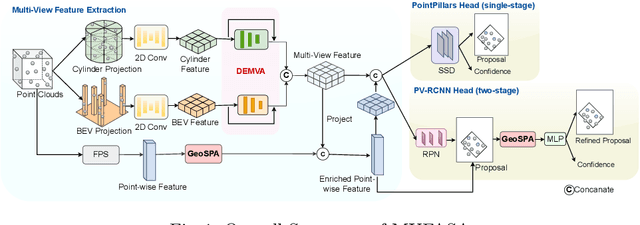
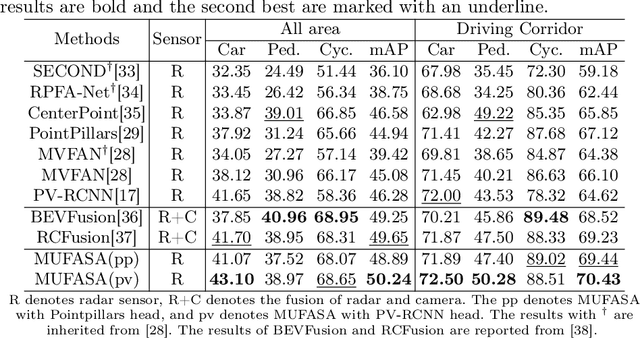
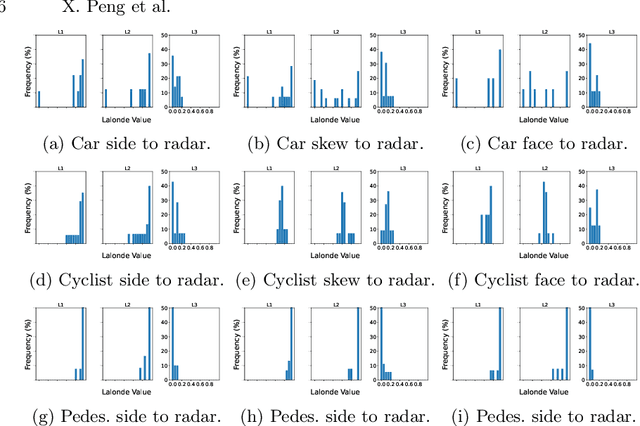

Abstract:In recent years, approaches based on radar object detection have made significant progress in autonomous driving systems due to their robustness under adverse weather compared to LiDAR. However, the sparsity of radar point clouds poses challenges in achieving precise object detection, highlighting the importance of effective and comprehensive feature extraction technologies. To address this challenge, this paper introduces a comprehensive feature extraction method for radar point clouds. This study first enhances the capability of detection networks by using a plug-and-play module, GeoSPA. It leverages the Lalonde features to explore local geometric patterns. Additionally, a distributed multi-view attention mechanism, DEMVA, is designed to integrate the shared information across the entire dataset with the global information of each individual frame. By employing the two modules, we present our method, MUFASA, which enhances object detection performance through improved feature extraction. The approach is evaluated on the VoD and TJ4DRaDSet datasets to demonstrate its effectiveness. In particular, we achieve state-of-the-art results among radar-based methods on the VoD dataset with the mAP of 50.24%.
CaFNet: A Confidence-Driven Framework for Radar Camera Depth Estimation
Jun 30, 2024Abstract:Depth estimation is critical in autonomous driving for interpreting 3D scenes accurately. Recently, radar-camera depth estimation has become of sufficient interest due to the robustness and low-cost properties of radar. Thus, this paper introduces a two-stage, end-to-end trainable Confidence-aware Fusion Net (CaFNet) for dense depth estimation, combining RGB imagery with sparse and noisy radar point cloud data. The first stage addresses radar-specific challenges, such as ambiguous elevation and noisy measurements, by predicting a radar confidence map and a preliminary coarse depth map. A novel approach is presented for generating the ground truth for the confidence map, which involves associating each radar point with its corresponding object to identify potential projection surfaces. These maps, together with the initial radar input, are processed by a second encoder. For the final depth estimation, we innovate a confidence-aware gated fusion mechanism to integrate radar and image features effectively, thereby enhancing the reliability of the depth map by filtering out radar noise. Our methodology, evaluated on the nuScenes dataset, demonstrates superior performance, improving upon the current leading model by 3.2% in Mean Absolute Error (MAE) and 2.7% in Root Mean Square Error (RMSE).
Enhanced Radar Perception via Multi-Task Learning: Towards Refined Data for Sensor Fusion Applications
Apr 09, 2024Abstract:Radar and camera fusion yields robustness in perception tasks by leveraging the strength of both sensors. The typical extracted radar point cloud is 2D without height information due to insufficient antennas along the elevation axis, which challenges the network performance. This work introduces a learning-based approach to infer the height of radar points associated with 3D objects. A novel robust regression loss is introduced to address the sparse target challenge. In addition, a multi-task training strategy is employed, emphasizing important features. The average radar absolute height error decreases from 1.69 to 0.25 meters compared to the state-of-the-art height extension method. The estimated target height values are used to preprocess and enrich radar data for downstream perception tasks. Integrating this refined radar information further enhances the performance of existing radar camera fusion models for object detection and depth estimation tasks.
Multi-Task Cross-Modality Attention-Fusion for 2D Object Detection
Jul 17, 2023



Abstract:Accurate and robust object detection is critical for autonomous driving. Image-based detectors face difficulties caused by low visibility in adverse weather conditions. Thus, radar-camera fusion is of particular interest but presents challenges in optimally fusing heterogeneous data sources. To approach this issue, we propose two new radar preprocessing techniques to better align radar and camera data. In addition, we introduce a Multi-Task Cross-Modality Attention-Fusion Network (MCAF-Net) for object detection, which includes two new fusion blocks. These allow for exploiting information from the feature maps more comprehensively. The proposed algorithm jointly detects objects and segments free space, which guides the model to focus on the more relevant part of the scene, namely, the occupied space. Our approach outperforms current state-of-the-art radar-camera fusion-based object detectors in the nuScenes dataset and achieves more robust results in adverse weather conditions and nighttime scenarios.
Utilizing Explainable AI for improving the Performance of Neural Networks
Oct 07, 2022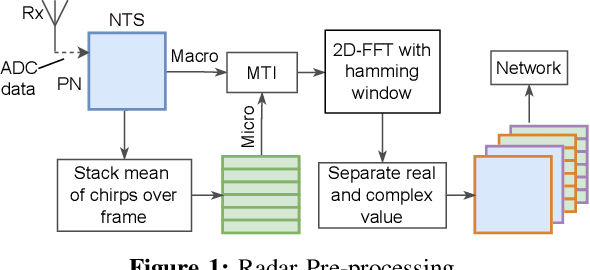

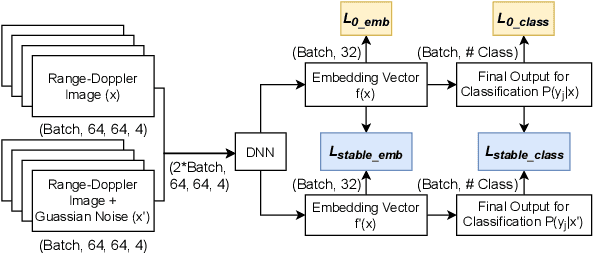

Abstract:Nowadays, deep neural networks are widely used in a variety of fields that have a direct impact on society. Although those models typically show outstanding performance, they have been used for a long time as black boxes. To address this, Explainable Artificial Intelligence (XAI) has been developing as a field that aims to improve the transparency of the model and increase their trustworthiness. We propose a retraining pipeline that consistently improves the model predictions starting from XAI and utilizing state-of-the-art techniques. To do that, we use the XAI results, namely SHapley Additive exPlanations (SHAP) values, to give specific training weights to the data samples. This leads to an improved training of the model and, consequently, better performance. In order to benchmark our method, we evaluate it on both real-life and public datasets. First, we perform the method on a radar-based people counting scenario. Afterward, we test it on the CIFAR-10, a public Computer Vision dataset. Experiments using the SHAP-based retraining approach achieve a 4% more accuracy w.r.t. the standard equal weight retraining for people counting tasks. Moreover, on the CIFAR-10, our SHAP-based weighting strategy ends up with a 3% accuracy rate than the training procedure with equal weighted samples.
Label-Aware Ranked Loss for robust People Counting using Automotive in-cabin Radar
Oct 12, 2021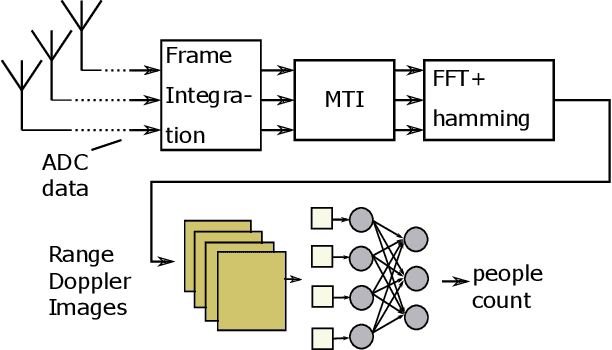
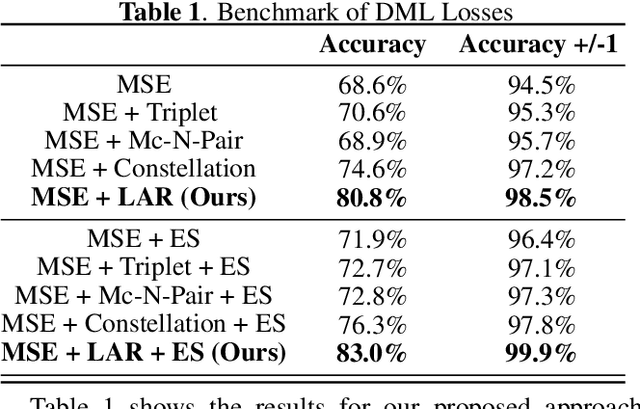
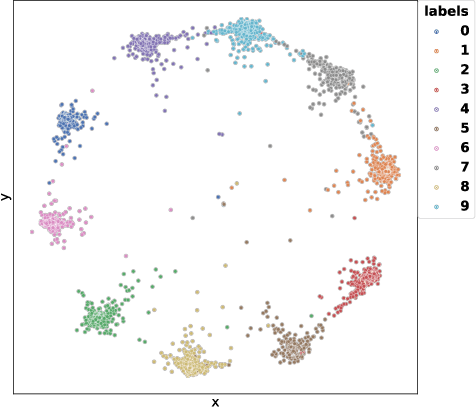
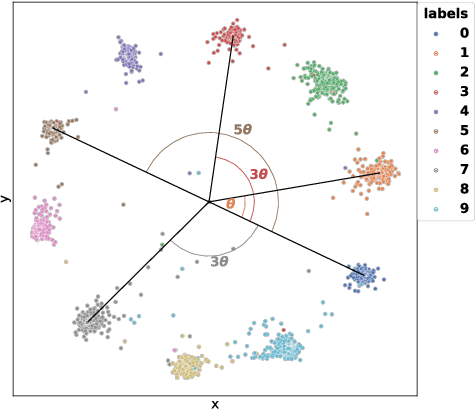
Abstract:In this paper, we introduce the Label-Aware Ranked loss, a novel metric loss function. Compared to the state-of-the-art Deep Metric Learning losses, this function takes advantage of the ranked ordering of the labels in regression problems. To this end, we first show that the loss minimises when datapoints of different labels are ranked and laid at uniform angles between each other in the embedding space. Then, to measure its performance, we apply the proposed loss on a regression task of people counting with a short-range radar in a challenging scenario, namely a vehicle cabin. The introduced approach improves the accuracy as well as the neighboring labels accuracy up to 83.0% and 99.9%: An increase of 6.7%and 2.1% on state-of-the-art methods, respectively.
 Add to Chrome
Add to Chrome Add to Firefox
Add to Firefox Add to Edge
Add to Edge